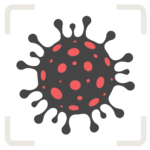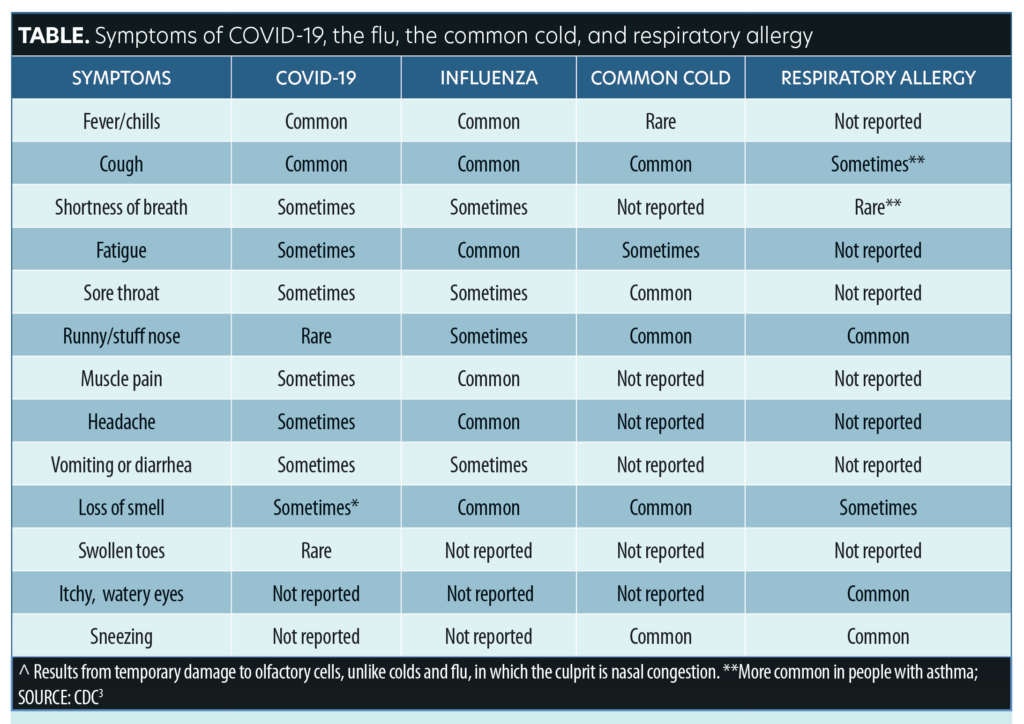 While our attention has understandably shifted to the COVID-19 when it comes to monitoring our health this winter, it would be a mistake to disregard other illnesses
While our attention has understandably shifted to the COVID-19 when it comes to monitoring our health this winter, it would be a mistake to disregard other illnesses
or conditions that are common when the weather is cold, such as the flu, the common cold, and respiratory allergies. But the conundrum: how do you distinguish one from the other? The flu, common cold, and COVID-19 are all contagious respiratory illnesses, each caused by a different virus, while respiratory allergies are typically triggered by environmental factors (e.g., dust, mites). However, there is a fair amount of symptom cross-over between these four illness (see Table below), and distinguishing which is which can be challenging. Here we describe the causes, symptoms, and treatments of each condition, as well as attempt [this was tough] to provide their unique characteristics.

COVID-19
COVID-19 is a virus that is categorized under the viral designation of coronavirus, a group of ribonucleic acid (RNA) viruses that are common causes of upper respiratory infections. COVID-19, which stands for corona virus disease-2019 [as in the year], specifically refers to the virus SARS-CoV-2— which is short for severe acute respiratory syndrome coronavirus 2 of the genus Betacoronavirus.2
Like the flu and common cold, COVID-19 is primarily transmitted via respiratory droplets—produced when an infected person sneezes, coughs, talks, or breathes—that are inhaled into the lungs or introduced into the body after touching a surface contaminated with the virus and then touching the nose, mouth, or eyes.[1] According to the US Centers for Disease Control and Prevention (CDC), COVID-19 appears to spread more easily than the flu, and “older adults and people who have severe underlying medical conditions like heart or lung disease or diabetes seem to be at higher risk for developing more serious complications from COVID-19 illness.” It can also take longer for symptoms to become apparent in COVID-19-infected individuals compared to those infected with the flu. The incubation period for COVID-19 is thought to be anywhere from 2 to 14 days, and symptoms typically start manifesting 4 to 5 days after exposure. People with the COVID-19 are more likely to be asymptomatic carriers of the virus than people with the flu, which is likely why the virus is so easily and rapidly spreading.[1,2]
The most common symptoms of COVID-19 are similar to those of the flu, and include fever, dry cough, and fatigue. Other symptoms can include shortness of breath, achy muscles, sore throat, and new loss of taste or smell. Less common symptoms include diarrhea, nausea, runny nose, and red eyes. Compared to the flu and the common cold, COVID-19 symptoms can last longer and require a more extended recovery time. People with mild cases usually recover in less than two weeks without requiring professional medical intervention, but recovery in more severe cases might last more than six weeks and require medical care.[3] There appears to be longer-term and more severe heath consequences and complications that can be caused by COVID-19, compared to the flu, including sepsis, organ failure, pneumonia, and inflammation of the heart, brain, or muscle tissues.[2]
Until the vaccine becomes available to the general public, which is predicted to be some time this spring in the US, the best means of prevention are social distancing, wearing a mask, frequent handwashing with soap and water, and getting COVID-19 tested if exposure is suspected or symptoms develop.[1]
THE FLU
The flu is a respiratory illness that infects the nose, throat, and, occasionally, the lungs.[3,4] It is caused by the influenza (flu) virus, of which there four types: A, B, C, and D. Types A and B are responsible for the flu epidemics that occur almost every winter in the United States, and Type A is the only influenza virus known to cause flu pandemics. For example, the Spanish flu, or the 1918 flu pandemic, was caused by the Type A subtype, H1N1, which resulted in over one-third of the world’s population becoming infected, and an estimated 50 million deaths worldwide.[1] Type C influenza infection generally causes only mild illness and is not associated with flu epidemics. Type D primarily affects livestock, and does not cause illness in people.[3,4]
Like COVID-19, the flu is spread through exposure to the respiratory droplets of an infected person or by touching a surface contaminated by virus-containing respiratory droplets and then touching the eyes, mouth, or nose.[4] About one-third of the people infected with the flu remain symptom-free, and infected people are most contagious during the first 3 to 4 days after their illness begins. The incubation period for the flu in most healthy adults is shorter than COVID-19, usually 3 to 4 days, but infected individuals can spread the illness to others as early as one day before their symptoms appear and for as long as seven days once symptoms manifest.[4]
Similar to COVID-19, symptoms of the flu can include fever, chills, cough, shortness of breath or difficulty breathing, fatigue, sore throat, runny or stuffy nose, muscle pain or body aches, and/or headache. Some people may experience vomiting and/or diarrhea, though this is more common in children than adults.
The flu requires a relatively mild recovery period in most cases, lasting from a couple days to less than two weeks, and typically does not require professional medical care, though more severe cases may require specific treatment and require a longer recovery period.[5] The flu virus can have long-lasting health consequences, some of which are similar to those seen in COVID-19 cases: the potential for sepsis, pneumonia, sinus infection, and/or inflammation in the heart, brain, or muscle tissues.[4,5] People at the highest risk of complications associated with the flu are older adults, people with certain chronic medical conditions (e.g., asthma, diabetes, heart disease), pregnant women, and children younger than five years old.[4]
The best way to prevent the flu is being annually vaccinated. The vaccine can also reduce the severity of the sickness if you do become infected. Regular hand washing and staying away from people who are sick are other effective ways to prevent contracting the flu.[4,5]
THE COMMON COLD
The common cold is considered a minor viral infection that affects the nose and throat. Rhinovirus is the most common cause of the cold, though certain types of coronavirus and respiratory syncytial virus (RSV) are also common causes, though less common than rhinovirus.[6]
While the common cold is symptomatically similar to the flu and COVID-19 in some ways, it is typically less severe with milder symptoms. Adults have an average of 2 to 3 colds per year, and children have even more. Like COVID-19 and the flu, the common cold can be spread through the air via respiratory secretions (e.g., sneezes, coughs); touching contaminated surfaces and then the nose, eyes, or mouth; or contact with fecal matter of an infected person. The incubation period for a cold is typically 1 to 3 days, depending on the level of exposure to the virus, how strong the individual’s immune system is, and how the virus entered the body.[6,7]
Symptoms of the cold typically include runny nose, congestion, sneezing, coughing, weakened senses of taste and smell, and/or scratchy throat. While fever can occur in young children infected with the cold, fever is not commonly seen in infected teens or adults.[6] Additionally, cold symptoms tend to manifest more slowly than those of the flu or COVID-19, which typically present suddenly.[6–8]
A full recovery from a cold usually takes 7 to 10 days, without medical intervention. Additionally, the common cold generally does not result in life-threatening or long- lasting health complications. Though rare, the common cold might lead to bacterial infections in other parts of the body, such as in the lungs (e.g., acute bronchitis) ears, or sinuses, which usually require antibiotic treatment by a medical professional.[7–9] A prolonged cough might also follow a cold, which can last from weeks to months, but this is typically noninfectious.[8]
The common cold does not have a specific treatment or vaccine, other than just letting it run its course. The best way to reduce its severity is to get plenty of rest, stay hydrated, and to treat its symptoms using over-the-counter medications (e.g., pain/fever reducers, decongestants, cough suppressants, antihistamines).
The best preventative measures for this illness include frequently washing hands with soap and water, frequently cleaning surfaces, self-isolation while infected, and strengthening the immune system through healthy lifestyle habits (e.g., healthy diet, physical activity, regular sleep). People of all ages can contract a cold, but factors, such as poor diet, cold weather, stress, lack of sleep, and smoking can make someone more susceptible to becoming infected with a cold and to suffer related complications.[7]
RESPIRATORY ALLERGY
Respiratory allergy is the outlier in this picture because it is not caused by a virus or bacterial infection. Respiratory allergy is a defensive response of the body to an environmental substance that is generally considered harmless to other people. Animals and animal byproducts (e.g., urine), dust mites, insects, mold, and pollens are common triggers of a respiratory allergic reaction.[9] Allergies are not contagious and can be hereditary. A respiratory allergy can last year-round or be seasonal, lasting from a few weeks to a few months.[9]
Symptoms of respiratory allergy include itchy, watery eyes; runny nose; nasal congestion; and/or sneezing. Some people might experience post-nasal drip, facial pressure and sinus headaches, and/ or mild fatigue. Post-nasal drip might cause some coughing in individuals, but generally this is not a significant symptom. While some symptoms of respiratory allergy are shared by the common cold, the flu, and COVID-19, the main difference is that respiratory allergy typically doesn’t cause fever or body aches, and symptoms of fatigue are less severe than those seen in patients with COVID-19.[10,11]
The best way to prevent or alleviate symptoms of respiratory allergy is to avoid environmental triggers. This can include frequently vacuuming your carpets, keeping humidity levels in your home between 40 and 50 percent, washing bedding weekly, and removing any mold growth on hard surfaces. Allergy symptoms can also be treated with over-the-counter or prescription antihistamines and nasal decongestants.[9]
CONCLUSION
If you suspect you have been exposed to COVID-19 or if you develop flu- or cold-like symptoms, consult with a qualified healthcare professional immediately.
SOURCES
- United States Centers for Disease Control and Prevention. COVID-19. Updated December 30, 2020. https://www.cdc.gov/coronavirus/2019-nCoV/index.html. Accessed 30 Dec 2020.
- Patrozou E, Mermel LA. “Does influenza transmission occur from asymptomatic infection or prior to symptom onset?.” Public Health Reports. 2009;124(2):193-6.
- Harvard Health Publishing website. If you’ve been exposed to the coronavirus. https://www.health.harvard.edu/diseases-and-conditions/if-youve-been-exposed- to-the-coronavirus. Updated November 20, 2020. Accessed November 24, 2020.
- United States Center for Disease Control and Prevention website. Influenza (flu). https://www.cdc.gov/flu/index.htm. Updated September 13, 2019. Accessed November 24, 2020.
- Harvard Health Publishing website. How long does the flu last? https://www. health.harvard.edu/staying-healthy/how-long-does-the-flu-last. Updated October 1, 2020. Accessed November 24, 2020.
- American Lung Association site. What Is a cold? Last updated 30 Oct 2020. https:// www.lung.org/lung-health-diseases/lung-disease-lookup/influenza/facts-about- the-common-cold. 30 Dec 2020.
- Seladi-Schulman J. What’s the incubation period of a cold? Healthline site. https:// www.healthline.com/health/incubation-period-for-cold. Updated March 8, 2019. Accessed November 24, 2020.
- United States Centers for Disease Control and Prevention site. Common colds. 11 Feb 2019. http://www.cdc.gov/features/rhinoviruses/index.html. Accessed 18 Jun 2020.
- Cleveland Clinic website. Common cold. https://my.clevelandclinic.org/health/ diseases/12342-common-cold. Updated April 20, 2020. Accessed November 24, 2020.
- Crockett R. Is it an allergy or the common cold? Mayo Clinic Health System website. https://www.mayoclinichealthsystem.org/hometown-health/speaking-of-health/ is-it-an-allergy-or-the-common-cold. Updated February 22, 2019. Accessed November 24, 2020.
- Mount Sinai site. How can I tell the difference between seasonal allergies and COVID-19? 14 Apr 2020. https://health.mountsinai.org/blog/how-can-i-tell-the- difference-between-seasonal-allergies-and-covid-19/#:~:text=The%20main%20symptoms allergic, it happen occasionally. 30 Dec 2020.





